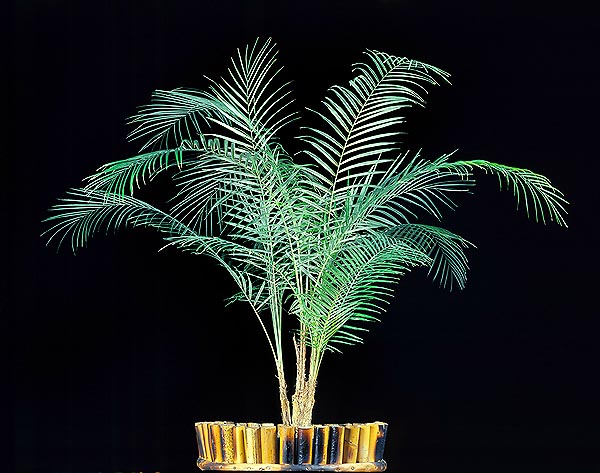Family : Arecaceae

Text © Pietro Puccio

English translation by Mario Beltramini

A typical indoor palm which can be 5 m tall in the wild © Giuseppe Mazza
is native to south-eastern Brazil where lives in the underwood of the humid forests at low and medium altitudes.
The name of the genus is the combination of the Greek words “lyton” = parted, divided, and “karyon” = seed, with reference to the characteristic of exocarp and mesocarp to dissect and open when ripe; the name of the species is honoured to the English botanist Hugh Algernon Weddell (1819-1877).
It is locally called “agué”, “ica”, “palmeirinha-de petropolis”, elsewhere: “Weddel palm”, “wedding palm”, “Victorian parlor palm” (English); “cocotier miniature” (French); “Miniatur Kokosnusspalme”, “Zimmer-Kokosplame” (German); “palmerita de Petropolis” (Spanish).
Solitary trunked plant, tall up to 5 metres with a diameter of 8-10 cm, wrapped in the younger part by fibres and by the remains of the petioles of the fallen-off leaves. The leaves are pinnate, light, long about 1 metre, with leaflets regularly inserted on the rachis in a plane, of dark green colour on the upper side, grey on the inferior one, long in the median part about 15 cm and wide up to 12 mm. The petiole and the rachis are covered by a brown-grey hair. The interfoliar inflorescences carry flowers of both sexes; the fruits are ellipsoidal, 2 cm long, of brown colour when ripe.
Very ornamental palm due to the elegance and the delicate beauty of its foliage, is suitable for humid tropical and subtropical climates in shady location; the cultivation in areas with warm temperate climate can be tried, avoiding heavy and alkaline soils, in sheltered position, shady and humid, as it resists, for a very short time, to temperatures around the -2, -3 °C. From the end of the nineteenth century it is cultivated in pot for the decoration of indoor spaces.
Synonyms : Cocos weddelliana H.Wendl. (1871); Syagrus weddelliana (H.Wendl.) Becc. (1916); Microcoelum weddellianum (H.Wendl.) H.E.Moore (1963); Glaziova elegantissima H.Wendl. (1871); Cocos insignis Mart. ex H.Wendl. in O.C.E.de Kerchove de Denterghem, (1878); Glaziova insignis Drude in C.F.P.von Martius & auct. suc. (eds.) (1881); Glaziova martiana Glaz. ex Drude in C.F.P.von Martius & auct. suc. (eds.) (1881); Calappa elegantina Kuntze (1891); Calappa insignis (Drude) Kuntze (1891); Cocos pynaertii auct. (1891); Cocos weddelliana var. pinaertii G.Nicholson & Mottet, (1899); Syagrus insignis (Drude) Becc. (1916); Syagrus weddelliana var. cinereus Becc. (1916); Syagrus weddelliana var. pinaertii Becc. (1916); Lytocaryum insigne (Drude) Toledo (1944); Lytocaryum weddellianum var. cinereum (Becc.) A.D.Hawkes (1952); Lytocaryum weddellianum var. pinaertii (G.Nicholson & Mottet) A.D.Hawkes (1952); Microcoelum insigne (Drude) Burret & Potztal (1956); Microcoelum martianum (Glaz. ex Drude) Burret & Potztal (1956).
→ For general notions about ARECACEAE please click here.
